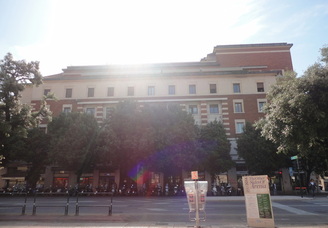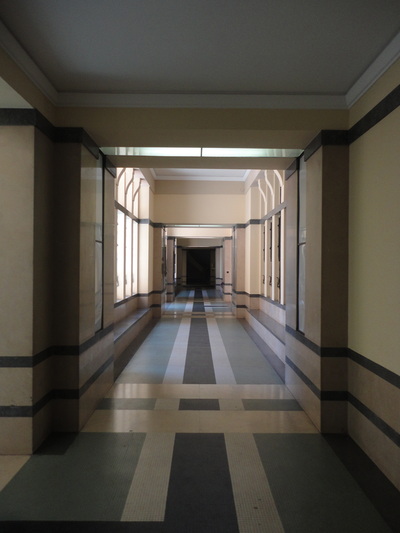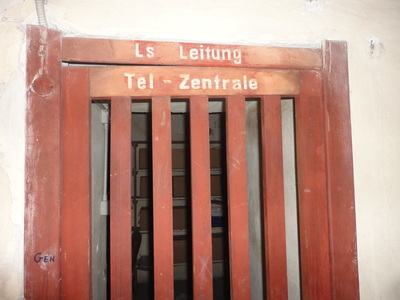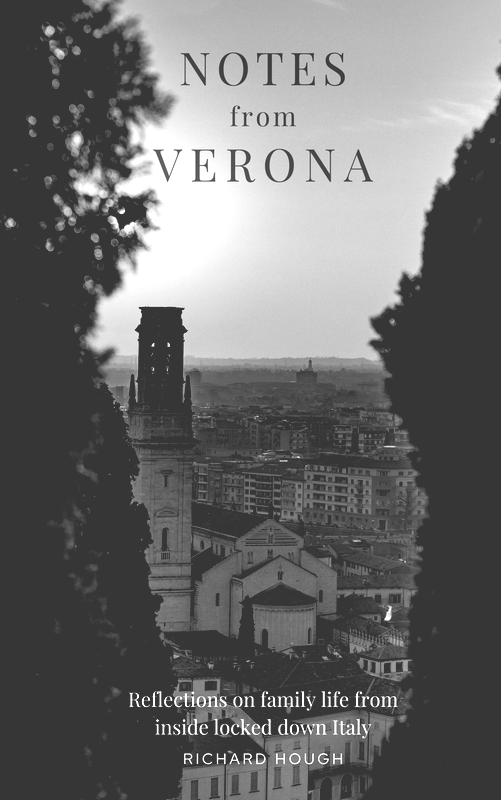 Memorial plaque, Palazzo dell'INA, Verona Memorial plaque, Palazzo dell'INA, Verona The Palazzo dell'INA is a blink-and-you miss-it office building on Corso Porta Nuova, just a few metres from Piazza Bra. As with many other remnants of the Second World War, I stumbled across this building in Verona quite by chance. Patiently waiting for a green man, I happened to glance upwards and noticed the plaque (see picture to the left). Well above head height on a busy street corner, it's easy to miss. Aside from the plaque, the palazzo's historical significance isn't immediately obvious. In search of further clues, I circumnavigated the building a couple of times and subsequently returned to surreptitiously explore the building's interior.  Palazzo dell'INA, Verona Palazzo dell'INA, Verona Once inside, even my inexpert eye recognised the tell-tale features of fascist-era architecture. Fascist architects in the 1920s and ‘30s drew inspiration from classical Roman buildings, but while Roman design has ornate details and rounded edges, fascist buildings are generally cold and forbidding. Symmetry, straight lines and simplicity (think Mackintosh but without the nice bits), the interior of the Palazzo dell'INA exudes conformity and order (see below). The Palazzo is now a busy office block and residence, with much coming and going. The maintenance work taking place in the enclosed courtyard at the back of the building adds to the general hustle and bustle, but most passers-by are completely oblivious to the building's dark past. [click to enlarge] On my third visit to the Palazzo, I meet the building's friendly concierge, who also happens to be something of an amateur historian. Without too much difficulty, I persuade him to show me the building's darker subterranean level, where traces of the buildings sinister past are still visible (see below).  Internal portico of the Palazzo dell'INA, Verona Internal portico of the Palazzo dell'INA, Verona The building was constructed in 1937, during the height of Italian fascism. Mussolini had been in power for 15 years. Built to house the istituto nazionale delle assicurazioni (the INA), it was designed in the style of Marcello Piacentini, a controversial figure in the history of architecture because of his strong association with the fascist regime. The building was part of a wider plan of urban restructuring, overseen by architect Paolo Rossi De Paoli. The onset of war meant that the other parts of the plan were never realised. Corso Porta Nuova, the elegant avenue on which Palazzo delle'INA is located was originally known as Corso Vittorio Emanuele II, after the famous Italian monarch. Throughout the period of the Repubblica Sociale Italiana (1943-1945), the street was renamed Corso Cangrande, in tribute to the famous 14th century warrior and autocrat.  Internal portico of the Palazzo dell'INA Internal portico of the Palazzo dell'INA Between September 1943 and April 1945, the period of the German occupation of Italy, Verona became the headquarters of the German military administration for the whole of occupied Italy and the operations centre of the Italian Gestapo. The headquarters of the commander of the Security Police and the Security Service of the SS occupied the Palazzo dell'INA. The upper floors were home to various commands and offices. The entrances and the corners of the building were protected by concrete casemates with slits for automatic weapons. Sentries were on guard 24 hours a day. The basement level was transformed into a prison. Although not large (average capacity was around 100), it was a feared interrogation and torture centre. Some traces of the building's past use are still visible in the basement, including original doors with German markings. [click to enlarge] Natale Mihel, a young antifascist, was only 17 years old when he spent a month imprisoned in the Palazzo dell'INA before being transferred to a camp at Bolzano. Although he suffered greatly, Mihel survived the camp and returned to Verona after the war. He subsequently emigrated to Switzerland but returns to Verona every now and then. In March 2014 he was awarded the diplomi di Onorificenza dell’Ordine “Al Merito della Repubblica Italiana”. In Berlin, the Reich Security Main Office, or RSHA, was the organisational centre behind the Final Solution, first under the command of Reinhard Heydrich and then his successor Ernst Kaltenbrunner. SS-Obersturmbannfuhrer Adolf Eichmann was the officer responsible for the Judenreferat, or Jewish Affairs Office, that would subsequently become known as IV B4. Its priority was the evacuation of Jews in German-occupied Europe. In Italy, arrest and deportation operations were overseen by the Gestapo and SS intelligence service. Verona was one of the railway hubs through which passed thousands of Italian Jews on their way to Mauthausen or Auschwitz-Birkenau, with the organisation and administration of that process being managed from the Palazzo dell'INA.
Many prominent Nazis were based in Verona during the German occupation of Italy and worked from the Palazzo dell'INA, including a number of so-called schreibtischtäter – ‘desk murderers’, who, with the stroke of a pen, condemned thousands to death. Men like Martin Sandberger, a former Einsatzgruppen commander in Russia, who took over the Gestapo in Verona in October 1943. At Nuremberg he was found guilty of crimes against humanity. He was released in 1951 and for decades he lived undisturbed in Germany. He died in a Stuttgart retirement home on 30 March 2010, taking the secrets of Palazzo dell'INA with him to his grave. |
AboutRichard Hough writes about history, football, wine, whisky, culture + travel and is currently working on a trilogy about wartime Verona.
|











